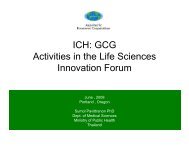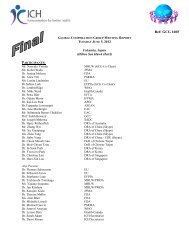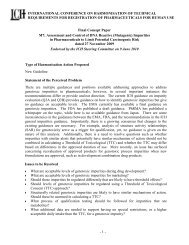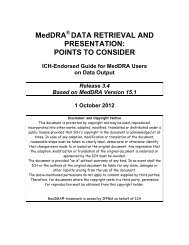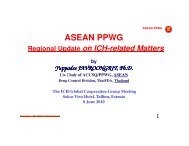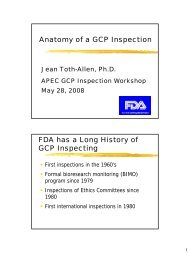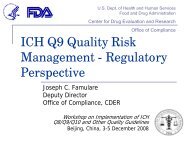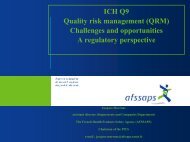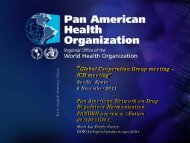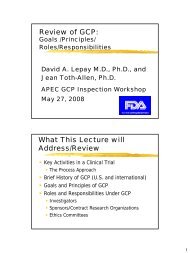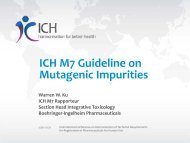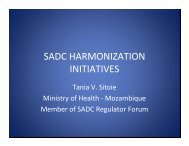2.3 â Good Regulatory Practices - ICH
2.3 â Good Regulatory Practices - ICH
2.3 â Good Regulatory Practices - ICH
You also want an ePaper? Increase the reach of your titles
YUMPU automatically turns print PDFs into web optimized ePapers that Google loves.
L1<br />
<strong>2.3</strong> – <strong>Good</strong> <strong>Regulatory</strong> <strong>Practices</strong><br />
Presentation to APEC Preliminary Workshop<br />
on Review of Drug Development<br />
in Clinical Trials<br />
Celia Lourenco, PhD,<br />
Manager, Clinical Group I<br />
Office of Clinical Trials<br />
Therapeutic Products Directorate<br />
1
Slide 1<br />
L1 Lourenco; 28.01.2008
Disclaimer: the information within<br />
this presentation is based on the<br />
presenter's expertise and<br />
experience, and represents the<br />
views of the presenter for the<br />
purposes of a training workshop<br />
2
<strong>Good</strong> <strong>Regulatory</strong> <strong>Practices</strong><br />
Develop regulations that are flexible<br />
Use risk management principles<br />
Be consistent in guidance and decision-making<br />
Be efficient in information and records management<br />
Measure and maintain performance and transparency<br />
Be reacheable and reach out to stakeholders<br />
Be aware of changing regional and global factors in<br />
R&D and access to drugs<br />
3
Flexibility of Regulations<br />
• Regulations should:<br />
– Cover principles broadly<br />
– Provide sufficient protection to the public<br />
– Strike a balance between protection of the<br />
public and enabling R&D<br />
– Be forward-looking, allowing flexibility for<br />
regulating in the current and future<br />
environment<br />
4
Use Risk Management Principles<br />
• Science-based risk management, with risk-based<br />
decision-making<br />
• Precautionary principle: “absence of full scientific certainty<br />
shall not be used as a reason to postpone decisions when<br />
faced with the threat of serious or irreversible harm”<br />
• Proactive – take initiative to address and prevent public<br />
health & safety concerns:<br />
– Safety of Canadian blood system<br />
– Bovine spongiform encephalopathy / Creutzenfeldt-Jakob disease<br />
– Pandemic influenza<br />
• Know own strengths and weaknesses:<br />
– Consult with experts on complex scientific, medical, or regulatory<br />
issues<br />
– Implement and make use of scientific advisory committees<br />
6
Consistency in Guidance and<br />
Decision-Making<br />
• Adopt international guidelines when appropriate<br />
• Develop SOPs:<br />
– <strong>Good</strong> guidance practices<br />
– <strong>Good</strong> review practices<br />
• Develop and implement guidelines to address<br />
regional issues<br />
• Be aware of drivers, such as globalization<br />
7
Efficiency in Information and Records<br />
Management<br />
• Develop and implement tools to manage documents<br />
and information submitted by sponsors<br />
– Maintain accurate records with a numbering system for<br />
sponsor/drug and submissions<br />
– Clinical trial applications, amendments and notifications<br />
– ADR database for integration and analysis<br />
– Submission allocation database<br />
– Clinical trial inspection database<br />
• System to manage other information such as general<br />
enquiries<br />
• Ensure security and maintain confidentiality of records 8
Measure and Maintain Performance and<br />
Transparency<br />
• Measure workload and performance at periodic<br />
intervals (e.g., quarterly)<br />
• Use information on workload and performance<br />
to develop/revise business plans<br />
• Publish performance measures periodically<br />
(e.g., annually)<br />
– Number of clinical trials, protocol amendments,<br />
notifications, ADRs, types of trials, etc.<br />
– Submission processing and review times<br />
9
Be Reacheable and Reach Out to<br />
Stakeholders<br />
• Provide opportunities for dialogue with sponsors and<br />
stakeholders formally and informally (e.g., pre-clinical<br />
trial meetings, telephone conferencing, informal email<br />
enquiries)<br />
• Provide for appeal processes and opportunities for<br />
reconsideration of final decisions<br />
• Consult with all stakeholders before implementing or<br />
adopting new regulations, policies, and guidelines<br />
• Consult with stakeholders as early as possible<br />
• Communicate horizontally within organization<br />
• Seek lessons learned through impact analyses<br />
10
Impact on R&D: Regional Factors<br />
• Analyze regional factors:<br />
– Population (e.g., demographics, disease prevalence)<br />
– Health care system and infrastructure<br />
– Available expertise<br />
– National support in research funding<br />
– <strong>Regulatory</strong> frameworks for importation and sale of<br />
drugs<br />
– Geographic location and neighbouring countries<br />
11
Impact on R&D: Global Factors<br />
Be aware of, and prepare for, global impact &<br />
trends:<br />
– Multinational clinical trials<br />
– Harmonization<br />
– Decreased number of blockbuster drugs & exponential<br />
rise in generics<br />
– Personalized medicine, pharmacogenomics<br />
– Rising costs and emerging markets<br />
– In choosing to place a clinical trial, companies will look<br />
for countries with the appropriate laws, along with the<br />
required population, disease prevalence, health care<br />
system, qualified investigators and staff, with high<br />
standards of professional integrity and ethics<br />
12
References<br />
Annual Drug<br />
Submission Report<br />
TPD Annual<br />
Performance<br />
Report<br />
Decision-Making<br />
Framework for<br />
Identifying,<br />
Assessing, and<br />
Managing Health<br />
Risks (2001)<br />
<strong>Good</strong> Guidance<br />
<strong>Practices</strong><br />
Ten Hallmarks of a<br />
<strong>Good</strong> Review<br />
<strong>Good</strong> Review<br />
<strong>Practices</strong><br />
http://www.hc-sc.gc.ca/dhp-mps/alt_formats/hpfbdgpsa/pdf/prodpharma/grp_fs_bpe_fd_v2_e.pdf<br />
http://www.hc-sc.gc.ca/dhp-mps/alt_formats/hpfbdgpsa/pdf/prodpharma/tpd_rep_dpt_rap_2006-07_e.pdf<br />
http://www.hc-sc.gc.ca/ahc-asc/pubs/hpfb-dgpsa/riskrisques_tc-tm_e.html<br />
http://www.hc-sc.gc.ca/dhp-mps/alt_formats/hpfbdgpsa/pdf/prodpharma/grp_bpe_princip_v2_e.pdf<br />
http://www.hc-sc.gc.ca/dhp-mps/alt_formats/hpfbdgpsa/pdf/prodpharma/tpd_dpt_annual_annuel_06_e.pdf<br />
http://www.hc-sc.gc.ca/dhp-mps/prodpharma/applicdemande/guide-ld/ggp-bpld/index_e.html<br />
13



